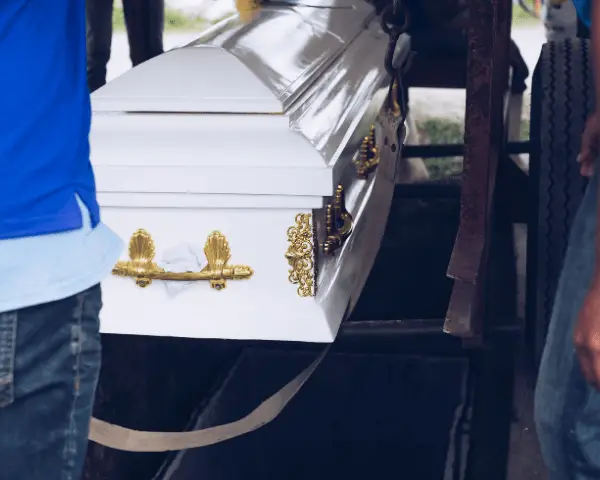Pallbearers are essential members of most funerals and they play a crucial role in giving the dearly deceased an honorable sendoff. If you are planning a funeral then you will certainly need to appoint some pallbearers. If you’ve been asked to be a pallbearer, then it’s quite normal to be feeling a little apprehensive. In both cases, you’re really going to find the following guide extremely useful.

What does a pallbearer do?
A pallbearer has the solemn honor of carrying a coffin or casket during funeral services. For cremations, the casket is only carried from the hearse into the crematorium by pallbearers. For burial services, the coffin is carried into the funeral venue, removed, and then carried to the graveside by the pallbearers.
The actual process of carrying the coffin can take a matter of minutes and the task is simpler when attending a cremation because there is only a single journey when you need to actually carry the coffin.
If you are acting as a pallbearer at a funeral that ends with a burial, expect to carry the coffin or casket from the hearse several times.
During the actual service, pallbearers don’t usually have a dedicated role, unless they’ve been asked to do something in addition to this task, and they aren’t necessarily expected to stand in front of a crowd.
How do you lift a coffin?
Lifting a coffin involves cooperation. The funeral director will arrange members according to height, tell them which shoulder they will rest the coffin on and which handle to stand near. As the coffin is slid out it is lifted from underneath while facing towards the hearse. Pallbearers then turn into the coffin, placing it on their shoulders.
The coffin shouldn’t be lifted by the handles as this makes placing it on the group’s individual shoulders difficult. Pallbearers also shouldn’t lift the coffin and then face the direction they intended to carry it. Instead, the coffin is arranged with the pallbearers initially facing the vehicle it came in.
Once the coffin is securely on the shoulders and everyone has a good grip, the pallbearers will pivot and turn to face the entrance of the building they are about to enter.
The reason that they have to do this is that traditionally a body will be transported with its feet travelling first (as it did in life), and so it is removed from the hearse head first and needs to be turned around.
How will you carry the coffin?
The thing that freaks people out the most about being a pallbearer is probably the question of how exactly do you carry a coffin or casket. often you’ll see pallbearers with the coffin expertly balanced on their shoulders, and this is easier to do than you may think.
However, the key thing that you will be told by a funeral director ( or anyone who is organizing the pallbearers) is that you should be comfortable carry the coffin. Some pallbearers will link arms to feel more steady, others will use their other hand to grip the coffin handles. All of these options are fine.
Don’t be afraid to do whatever you want in order to get a firm grip on the casket but do listen carefully to the directions you are given. Oftentimes it’ll be the funeral director telling you what to do and they are experts at this.
Who should be asked to be a pallbearer?
When planning a funeral it’s your job to invite people to be a pallbearer. Ideally, you want to do this beforehand, just for logistics, but you can also do it on the day. Oftentimes we can’t be sure that everyone will be able to make it to a funeral, especially after an unexpected death.
The best candidate for pallbearer is someone who was close to the deceased as it is a honored role leaving a lasting impression. Depending on the age of the deceased, siblings or even parents may be the obvious choice. Alternatively, adult children or other immediate family members can be considered.
As this can be a very emotional experience, it’s best not to ask those who have been most affected by the loss of the deceased. It’s a job, after all, that requires a certain amount of coordination and teamwork which you wouldn’t want to jeopardize by having someone who is deeply grieving carry it out.
For example, you might ask the son-in-law to be a pallbearer for their father or mother-in-law rather than the daughter and vice versa.
If there are no obvious candidates among family due to ability or absence, then you might turn to close friends or colleagues. If this is a dry source of pallbearers too, then the funeral home will be able to provide its own pallbearers.
How many pallbearers are needed?
You will need a minimum of four pallbearers and as many as six if available or if the casket is expected to be heavy. Due to the limited space flanking the casket, more than eight pallbearers are not feasible at one time. If required, different pallbearers can be used during other stages of the funeral.
As a funeral normally happens fairly quickly under normal circumstances, you should try to ask a couple of extra people to be backup pallbearers. For someone planning a funeral, it’s going to be a pretty emotional day so limiting the stress of a last-minute absence due to illness or work will be important.
How old should a pallbearer be?
When choosing a pallbearer you should consider age in terms of strength and maturity. As long as the candidate is physically able to lift their share of the coffin and will treat the task with the respect it deserves, they could be any age. Generally, however, it’s best to choose an adult who is going to be able to follow instructions and work well with the other pallbearers.
I remember being asked to be a pallbearer in my early 20s along with my younger brother who probably was still in high school. We had been very close to our elderly neighbor who had died and her daughter thought that we were mature and strong enough to be selected. I don’t think we let her down.
Can pallbearers be female?
Traditionally pallbearers seem to be depicted as males but there is absolutely no reason not to ask a woman to carry a coffin in the 21st century if they are able to bear the weight. However, it’s important to arrange this in advance so that the female pallbearers can wear footwear that won’t hinder them.
There are no hard and fast rules about women not being pallbearers, it just that many funeral traditions seem to be stuck in the past.
The only reason not to ask a woman to carry a coffin is if for some reason you want a uniform look to your pallbearers, in which case men are fairly boring and pick fairly similar outfits for funerals. That being said, it’s a pretty weak reason.
Who shouldn’t be a pallbearer?
Being a pallbearer requires a lot of concentration, coordination, and, to a certain extent, strength. This role also suggests a certain closeness, affection, or respect between the pallbearer and deceased. Those not physically, mentally, or socially not up to the task probably shouldn’t be considered.
I really wouldn’t consider anyone who was younger than their early teens (unless fairly well developed) or in their golden years to do this. You also don’t want to ask any family member or acquaintance who had ill-feeling with the deceased, now is not the time to stir up those emotions.
Unless completely out of other candidates, you shouldn’t ask a stranger, say the new boyfriend of your niece, to do it. Perhaps there isn’t anything practically wrong with it but there isn’t the same meaning to the proceeding when a complete stranger carries someone to their final resting place.
What should a pallbearer wear?
A good rule of thumb for a male pallbearer is to wear a white shirt, dark tie, and suit (navy, dark grey or black). Women should also opt for a dark dress or pants suit. Comfortable and practical footwear is vital. Generally, follow the culture and traditions for the type of funeral you are attending unless told otherwise.
If you’ve been asked to be a pallbearer, you should double-check on the dress code that the organizer wants. Although traditionally funerals call for dark-colored formal attire, the deceased may have a different and more fun approach to their final wishes.
Although wearing something smart is unlikely to offend people, you want to make the day as less stressful and uncomfortable for the family as you can.
Can a pallbearer wear sunglasses?
If you are close enough to be asked to be a pallbearer, then you probably know the values of the family involved and how they might view sunglasses. The obvious answer is to ask the family directly or the other pallbearers if you know them.
From s purely aesthetic standpoint, you would want all the pallbearers to be wearing sunglasses or non at all. In practical terms, if you are going from an extremely sunny exterior to a darker interior, sunglasses will make the job of carrying the coffin in step with others a lot more difficult.
Removing them while carrying the coffin isn’t going to be an option, so likely the best answer is to leave them in the car for later.
Can a pallbearer wear a uniform?
A uniform can add solemnity and meaning to the spectacle of a coffin being carried into a funeral and there are no traditional saying it should happen. However, it’s important to check with the family before doing this as they may have a certain theme or look they were hoping for.
If you are a current or former serviceperson wearing your formal uniform can be a wonderful way of marking the importance of the day. Nevertheless, remember that you will be in very close proximity with others so any part of your uniform which inhibits you walking or seeing might not be ideal for this task.
Will pallbearers get training?
If the funeral is being arranged and led by a funeral director the pallbearers will get training before carrying out their task. This training will involve an explanation of where the coffin will sit, which direction to turn and walk and how you can carry it with the most comfort.
Although not complex, there is a certain amount of choreography that goes into carrying a casket with 3 or 5 other people. If for some reason there isn’t a professional funeral director presiding over the running of the funeral, you can find a good explanation of the process in the video below.
Can you refuse to be a pallbearer?
It’s a real honor to be asked to be a pallbearer, but you can certainly decline the request if you want to. There are many reasons for this from poor health, an unreliable schedule, or not wanting the responsibility. Simply decline the invitation and explain the reason for not wanting to participate.
Let’s face it, this is one of the most important parts of the funeral proceedings and has the added stress of being so close to the body of the deceased. Although not a particularly difficult task, it’s by no means straightforward.
If you are convinced that you don’t want the role for whatever reason, tell the organizer as soon as you can so that they can find someone else. There is no shame in not accepting and it’s better to say no beforehand than to let the side down last minute or, worse, have a panic while the casket is on your shoulder.
Does height matter as a pallbearer?
It does not matter how tall you are when it comes to carrying a coffin, although four pallbearers of equal height is ideal. The funeral director will arrange pallbearers according to their height, normally with the shorter members being at the front (and feet) of the coffin.
if you are choosing the pallbearers yourself, then you can make it easier if you try to choose people of roughly the same height or pairs who measure up the same. You certainly don’t have to be tall to do the job, and you could, in theory, have a quartet of very short people doing the job
I’m really nervous about carrying a coffin
If you have agreed to be a pallbearer but are really anxious about actually carrying the coffin, then you aren’t alone. It’s not an every day activity and it’s probably going to be one of the most memorable events of your life. But that’s because of the occasion and not because anything bad will happen.
In my experience, people are nervous about being a pallbearer for the following reasons:
What if I drop the coffin?
This has to be the biggest worry, right? Well, it’s very unlikely because there are at least three other people just as worried about doing the same thing. You all work as a team and you can even keep a grip on the coffin’s handle if you want. It’s unlikely to go anywhere.
What if I trip?
Again, you aren’t the only one to worry about this. Remember that you will have a team of funeral home employees around you helping you look out for obstacles and coordinate your movements with the other pallbearers.
This is going to happen very slowly and as long as you are wearing good shoes you really don’t run the risk of tripping over your feet or anything else for that matter.
I’ve never been that close to a body
Most ordinary people in modern times havening ever seen a dead person and they will all be thinking the same as you. Although you will know that there is a body in the box on your shoulder, it’s still the person you knew and loved. They aren’t going to fall out, or make any noises. Also, you aren’t going to have any unpleasant smells coming out or anything like that.
The fact of the matter is that you will be so focused on your footsteps that you won’t be thinking about who you are carrying at that particular moment.
What happens if there are no pallbearers?

If there are no good candidates for pallbearers among family and friends then the funeral home will provide its own. It’s usually possible to arrange a mix of staff and other mourners if only one or two people are willing to be pallbearers. This should be arranged as early as possible.
Professional funeral directors are used to stepping in as pallbearers and they can certainly arrange this when needed. Oftentimes when there is no family member or friend able and willing to carry the coffin it falls to the funeral home staff. be aware that this may not be covered in the basic fee, so you need to check with your funeral director.
Do you need pallbearers at a cremation?
Pallbearers are usually required whenever a coffin is moved from one location to another. Most funeral homes aren’t associated with the local crematorium, so the body will need to be brought there to be cremated. Special arrangement to transfer the coffin before the ceremony may be requested if needed.
Usually, the body of the deceased will be stored at the funeral home where several other services will be carried out ( embalming, dressing, preparation, etc.). So, for the actual service at a crematorium, the funeral director will need to bring the body to that location. If this is done as part of the funeral you will want to have pallbearers.
Being a pallbearer in the rain
Being a pallbearer in rain only requires that you dress appropriately and take extra care when walking on stone and grass surfaces. Be sure to wear a smart coat and to wear dress shoes with good grip on them. Others can carry umbrellas to protect both the pallbearer and coffin if needed.
Of course, the wet isn’t ideal when you have to carry a heavy coffin, but many have done it before you. The funeral director will give you the right advice and probably advise everyone to take things even more slowly than they would on a sunny day.
Consider checking your shoes on slippery surfaces before setting out to the service and perhaps wear some dark leather gloves to give you a better grip.
How much does a coffin or casket weigh?
The average coffin or casket will weigh between 150 and 250 pounds (68-113 kg) empty. The average weight of American adults is about 181 pounds (82kg). So, pallbearers need to carry a quarter of between 331 and 431 pounds (150-195 kg). However, different materials make lighter coffins and the decease may be heavier.
According to my friends over at Titancasket (who have fabulously well-priced caskets for sale – see my link here), the materials used in modern casket design actually give a range of casket weight between 70 and 250 pounds (31-113 kg), but the most commonly used material remain in the 150 -250 pound (68-113 kg) range.
The size and design, including accessories, will obviously affect the final weight of the casket, but below you can find a rough guide to the types of material which are heaviest.
| Casket material | Weight (lbs) | Weight (kg) |
|---|---|---|
| Wood | 150 -250 | 68-113 |
| Metal | 170-190 | 77-86 |
| Plywood, Fiberboard and Cardboard | 70-80 | 31-36 |
How long and far do you have to carry a coffin?
There are a few main journeys that pallbearers have to take while carrying a coffin or casket. For cremations, it will be merely from the hearse to the front of the crematorium. The coffin is normally removed via conveyor from that point without the assistance of pallbearers.
For burials, the pallbearers will probably need to take the coffin from the hearse into the venue for the funeral service (unless it’s happening at the funeral home itself), then back into the hearse so that it can be transported to the cemetery. At this point, the pallbearers need to take the coffin from the hearse to the graveside.
As you will be doing this at dedicated places for this event, the distances shouldn’t be very far. Also, the hearse will be given priority for parking, so this means that time spent carrying the coffin outside should be minimal.
If you have been asked to be a pallbearer and you have physical limitations when it comes to carrying significant weight over a fairly short distance, voice those concerns early on. You can talk to the family who is holding the funeral or the funeral director to get advice. If really unsure, try to excuse yourself early on and help find a replacement.
Can you hire professional pallbearers?
If you are the one planning a funeral and you don’t have any friends or family of the deceased to act as pallbearers, you can request the funeral home to provide some. They will usually have staff members who have done this countless time and will deliver your loved one to the right places at the correct time with respect and dignity.
It will depend on the funeral home whether this actually comes as an added cost, so be sure to ask about this before signing or agreeing to the final price of the funeral.
Do you tip pallbearers at a funeral?
If a pallbearer is a family member or known to be a friend, it’s not usually to tip them. They are carrying out this task out of respect for the deceased. For non-funeral members or those on the funeral home staff, it is acceptable to offer a tip of no more than $50. It will be up to them to refuse, share or otherwise inform you of the company’s policy on gratuities.
If you are at all unclear of the identity of a pallbearer, you can ask other funeral-goers for advice or even strike up a friendly conversation with them before deciding whether or not to show your appreciation with a tip.
Should pallbearers wear boutonnieres?
It’s traditional for pallbearers to wear a boutonniere in their jacket’s lapel. This is both to distinguish them from other funeral attendees as well as giving them something to show a last mark of respect. After delivering the coffin to its final destination each pallbearer will place their boutonniere on the coffin in turn as they leave.
If you have been asked to be a pallbearer, be sure to check with the organizers to see if this is one of the traditions being followed. Make sure that you wear a jacket and one which already has a hole for a boutonniere if possible.
If you were close to the deceased, feel free to take a short moment as you place the boutonniere on the casket to say a short prayer or some parting words.
Pulling out from being a pallbearer at the last minute
Having to renege on being a pallbearer happens more than you might think and isn’t a huge logistical nightmare. if you can’t be a pallbearer due to absence, make sure you notify the family and/or funeral directors as soon as you can. if possible, find a replacement among friends or family. Most people will understand if the unavoidable happens. Just tell those concerned as soon as possible.




